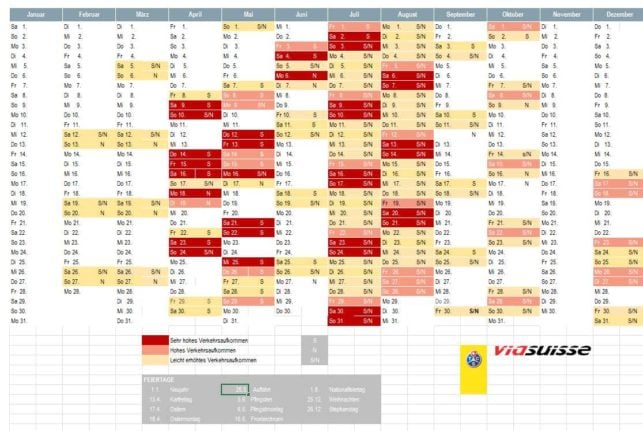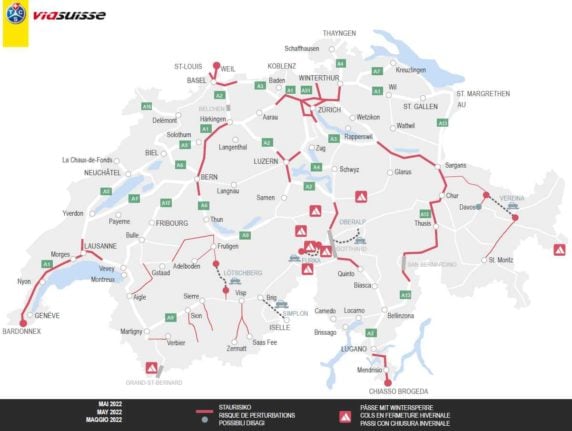With narrow, winding roads and city and town centres which were designed long before cars were thought up, traffic in Switzerland can be terrible at the best of times.
But things get particularly stuck on weekends and holidays, where people from Switzerland and abroad clog up the nation’s motorways, which can put a real dampener on your holiday plans.
READ MORE: Swiss politicians call for ‘lost’ public holidays to be replaced
While most locals will be able to recognise when heavy traffic days are coming up so they can stay well away, new residents and tourists may have a harder time.
To help out, Touring Club Suisse, Switzerland’s largest motor and mobility authority, each year comes up with the Traffic Jam Calendar, which lists the times of the year when traffic can be particularly bad.
The calendar ranks days on four different traffic levels.
The standard days are in white, while slightly higher traffic days are in yellow.
Days with a high traffic volume are listed in pink/orange, while very high traffic volumes are listed in red.

The calendar shown above relates to 2022. The calendar for the current year can be seen here.
When is traffic particularly bad in Switzerland?
As can be seen from the calendar, the main days for bad traffic are in spring and summer.
Not only are these the days when the weather is best, but they’re also peak tourist season for domestic and foreign tourists.
READ MORE: When are the public holidays in Switzerland in 2022?
While there is not one very high volume traffic day in Switzerland from the start of September until the end of March, there are 32 from April to August.
April alone has eight along with several high traffic days, due largely to the Easter holidays over the weekend of the 16th and 17th. In May, traffic ramps up before Ascension Day on the 26th.
In June, Corpus Christi (3rd) and Whit Monday (6th) will both see high travel volumes.
The situation is particularly serious in July and August however, where very weekend day has high traffic volumes.
Even weekdays in these two months have increased traffic volumes, meaning that taking a day off and leaving earlier/coming back later will not be guaranteed to save you some time.
Bottlenecks and delays: Which Swiss cities have the worst traffic?
Where is traffic the worst in Switzerland?
While the traffic calendar goes into specifics about the days when wait times are worst, it says little about which locations are set to see traffic surges.
To fix this, TCS regularly releases information about upcoming holidays and where things are likely to get tight.
In May, TCS released a map of the likely traffic hotspots for the Ascension (26th May) and Pentecost holidays (June 5th).
As can be seen here, the roads around Zurich including the A1 and the A51 are particularly busy, as is the A1 near Geneva.
The Gotthard Pass, often a site of traffic jams, is also set to be particularly busy.
For holiday makers, the A13 in the east of the country is also tipped to see very high traffic volumes over the Ascension and Pentecost weeks.

You can download the live road information for Switzerland as an app for iPhone and Android



 Please whitelist us to continue reading.
Please whitelist us to continue reading.
Member comments